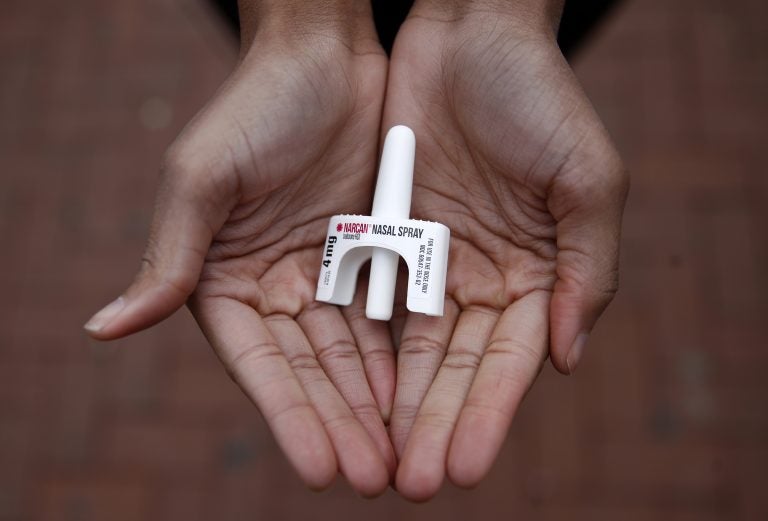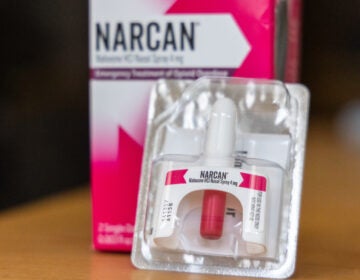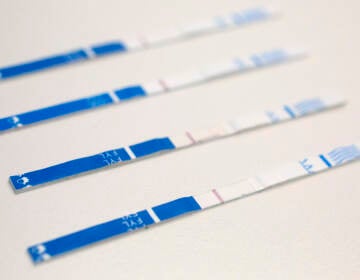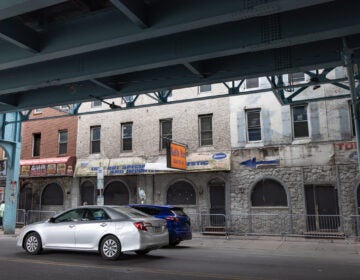Black Pennsylvanians are 50% less likely to receive naloxone, despite soaring overdose deaths, new study finds
Cultural, systemic and historical factors have converged to create the perfect storm when it comes to Black overdose deaths.
Listen 1:05
In this Jan. 23, 2018 photo, Leah Hill, a behavioral health fellow with the Baltimore City Health Department, displays a sample of Narcan nasal spray in Baltimore. The overdose-reversal drug is a critical tool to easing America’s coast-to-coast opioid epidemic. (AP Photo/Patrick Semansky)
From Philly and the Pa. suburbs to South Jersey and Delaware, what would you like WHYY News to cover? Let us know!
A recent study from the Pennsylvania Department of Health has found that Black people who died from opioid overdoses were half as likely as white people to receive the life-saving drug naloxone, otherwise known as Narcan. The study also found that Black overdose deaths in Pennsylvania increased by more than 50% between 2019 and 2021, compared with no change in white overdose deaths.
In an email, a representative with the Department of Health said that similar rises in overdose deaths are being seen across the country, especially among Black, American Indian and Alaska Native populations. But researchers are still investigating what’s behind the spike.
“There does not appear to be a single reason why rates are increasing for Black populations and holding steady among white populations,” the statement reads. “The volatile and rapidly changing drug supply certainly has been a challenge as fentanyl is now found in every type of drug. Inequities in terms of treatment for substance use disorder may also play a factor as white people are more likely to have better access to the most evidence-based treatments and are more likely to stay in treatment.”
Fear of arrest
Abenaa Jones, an epidemiologist and assistant professor of human development and family studies at Penn State who was not involved in the study, has conducted similar research in Baltimore. She agreed that fentanyl-contaminated drugs — which are more common in lower-income neighborhoods — and less access to health care are likely factors in the growing number of overdose deaths among Black populations.
Jones said the criminal justice system, and its unequal treatment of Black people, also plays a role.
“We know that the intersection of criminal justice and substance use, and criminalization of drug use and how that disproportionately impacts minorities, can limit the accessibility of harm reduction services to racial-ethnic minorities for fear of harassment by police for drug paraphernalia,” Jones said, adding that even syringes obtained through needle-exchange programs can be considered illegal paraphernalia.
Fear of arrest, in turn, leads more people to using drugs in isolation.
“That may protect you from criminal legal involvement, but then in the event of an overdose, you may not have someone to help you,” Jones said. “So it could be that by the time the EMS come, it’s been too long for them to even consider administering naloxone.”
Contaminated drug supplies
An unexpected observation that Jones made in the course of her research could also be a factor in rising death rates — the fact that many of the Black people dying of opioid overdoses are older.
“For any other racial groups, overdose deaths peak around midlife — 35, 45,” she said. “For Black individuals, it’s more like 55, 64, and we were wondering what was going on with that.”
After investigating that question, Jones and her colleagues formulated a working theory.
“The running hypothesis for us is that this is a cohort effect,” she said. “Individuals who’ve been using drugs over time, particularly Black individuals back from the ‘80s and ‘90s with the cocaine epidemic, never stopped using.”
Those individuals may have remained relatively stable until fentanyl began to contaminate their drug supply without them knowing.
“So whatever harm reduction tools that you were using for so many years that’s been helping you, when fentanyl’s involved, it’s a different game,” Jones said. “You have to use less, but you have to also know that you have fentanyl in your drugs, right?
It’s a problem that Marcia Tucker, the program director of Pathways to Recovery — a partial hospitalization program focused on co-occurring substance use and mental health challenges — sees frequently among their mostly Black clients.
“If you come into treatment saying that I’m a cocaine user, or I’m a crack cocaine user, or I use marijuana, you’re not even thinking that an opioid overdose or fentanyl overdose could possibly happen to you,” Tucker said. “And it does happen.”
Fear, stigma and miseducation
In fact, Tucker said, she’s seen more of these kinds of overdoses over the past two years than in the three decades she’s spent working in addiction treatment. Despite that, there’s still a lack of education — and even stigma — surrounding both medication-assisted treatments (MATs) for opioid addiction, and the use of naloxone.
“I think sometimes culturally with the African American community, as far as MATs are concerned, there are some taboos about getting that extra help when they decide to come into treatment and get clean,” she said. “A lot of people feel like they want to do it from the muscle. They see it as another form of using.”
She said others may not know how to use naloxone, what kinds of effects it has or how to get it.
“I think a lot of folks don’t even know that they can walk into a pharmacy and get naloxone — you don’t have to have a prescription for that,” Tucker said. “And I think that information is just not always presented to communities, especially poor communities that don’t have a lot of resources.”
Other sources of hesitation are more immediate. Aaron Rice, a therapist at Pathways to Recovery, said that many of their clients fear naloxone because of its physical effects.
“I think they associate it with precipitated withdrawal at times,” Rice said, referring to the rapid-onset withdrawal that can cause symptoms including anxiety, pain, seating, nausea, vomiting and diarrhea.
“The only thing they’re thinking about is feeling better. And that feeling is going to supersede logic at that moment. It always does.”
Overcoming disparities in health care and mistrust of the system
The Department of Health acknowledged that the study only paints a partial picture, as it doesn’t include individuals whose overdoses were reversed by naloxone, and added that during the years of the study (2019–2021), naloxone was available by prescription only — a fact that likely played into the race-based disparity.
“There are recognized inequities in access to health care among persons of color, the concept of which likely extends to access to naloxone,” the Department of Health statement reads. “Historically, many public health materials and messaging more narrowly focused on persons using opioids. With people now taking two or more drugs together (whether intentionally or unintentionally), public health materials and messaging need to be more inclusive of all persons using drugs, regardless of the type.”
The study, researcher Abenaa Jones, Marcia Tucker and Aaron Rice all agreed on at least one intervention that could increase Black people’s access to naloxone — relying on trusted community leaders and institutions, like churches, to help educate residents and distribute the overdose-reversing drug.
“I just can’t stress enough how it’s a lifesaver — it’s the difference between life and death,” Tucker said. “I think people who aren’t medical professionals and find themselves in a situation where it might need to be used would probably be a little fearful — fearful about how to use it or how the person is going to react or whether it’s really going to work — just know that you’re better off with it and trying it. You don’t want to have to second guess yourself later and say, ‘I wish we had it. I wish we had gotten it,’ or, ‘I wish we had used it.'”

Get daily updates from WHYY News!
WHYY is your source for fact-based, in-depth journalism and information. As a nonprofit organization, we rely on financial support from readers like you. Please give today.








